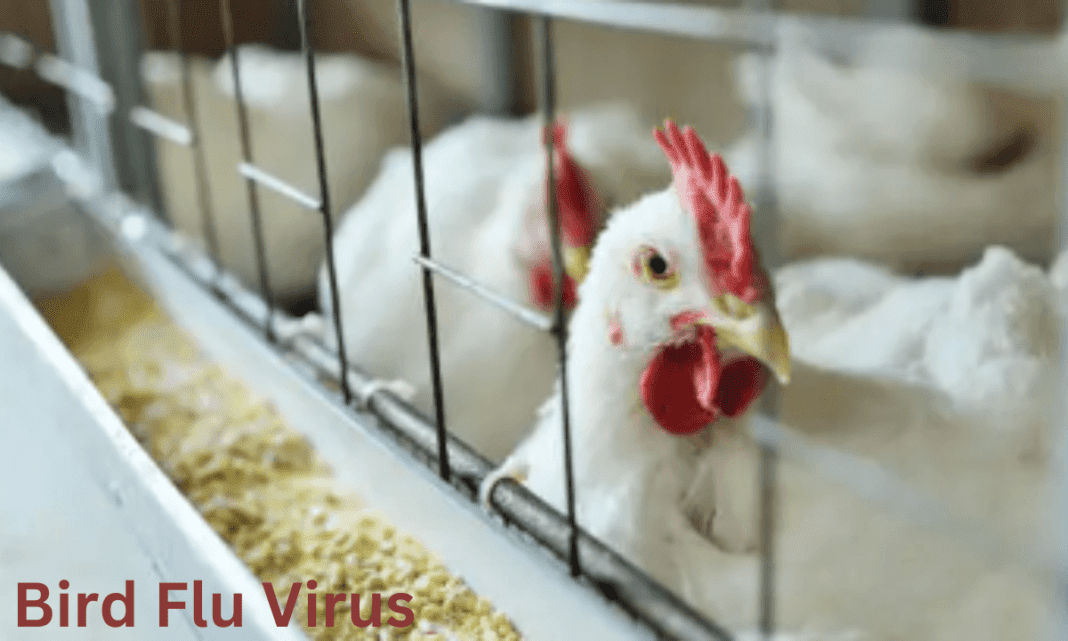Bird Flu Virus: Infections in Humans
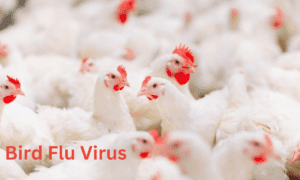
The consequences of the two most common human bird flu virus, H5N1 and H7N9, are similar. Fever, cough, sore throat, and muscular aches are flu-like symptoms that people could experience. The common cold might affect some people. Some people suffer from pneumonia or trouble breathing.
Although humans seldom become infected with avian influenza (flu) a virus, there have been sporadic human infections. Human cases of illness caused by avian flu viruses have varied in severity, from complete absence of symptoms or moderate sickness to fatal complications.
Most human diseases from avian influenza viruses documented worldwide to date, including the most severe illnesses with high mortality, have been caused by the A(H7N9) virus, the A(H5N1) virus, and the A(H5N6) virus, which are highly pathogenic avian influenza (H.P.A.I.).
What is The Bird Flu Virus:
The influenza virus infects birds is, known as bird flu or avian flu. Occasionally, it may have an impact on people.
The avian flu virus comes in many varieties. Nobody gets sick from most of them. Concerning strains that have emerged in the past few years are:
- H5N1 infections have been reported since 1997
- H7N9 (1993–present)
- Influenza A (H5N6) (since 2014)
- The H5N8 pandemic has been around since 2016.
A handful of individuals have been infected and have died as a result of H5N1, H7N9, and H5N6, even though these viruses do not often infect humans and do not typically pass from person to person.
The first confirmed case of H5N8 infection occurred in February 2021 in Russia, where a few persons were afflicted.
The Human Virus Infections
The virus’s potential for human-to-human transmission remains unproven. On the other hand, under highly unusual circumstances, this may have occurred when a person contracted an illness while tending to a sick relative.
The avian flu virus can be transmitted from human to human. Scientists worried that it may change after merging with the human flu virus.
At this time, the H5N1 strain of avian flu is impacting Asia. More than 130 individuals have been killed by this strain in Iraq, Vietnam, Cambodia, Thailand, Turkey, Azerbaijan, Egypt, and Indonesia since 2003.
Australia has successfully contained and eradicated multiple outbreaks of avian flu in commercial flocks of birds.
Type A(H5N1)


In 1996, the A(H5N1) avian influenza virus first appeared. Hong Kong and southern China were the initial locations where it was found. As a highly virulent avian influenza virus, A(H5N1) is responsible for the deaths of a large percentage of infected birds.
Adaptations to people still need to be improved. No persistent transmission has been recorded between humans, and transmission from birds to people is rare. In humans, though, it can induce serious illness.
Until 2021, the A(H5N1) virus was only infrequently found in European wild birds and poultry. The most significant outbreaks of A(H5N1) in both wild and farmed birds in Europe have occurred since then. In the 2021–2022 pandemic alone, it killed almost 50 million birds.
Part A(H7N9)
An innovative bird flu A(H7N9), a virus that causes severe human sickness, was discovered in China in March 2013. A low-pathogenic avian flu strain was initially detected at this location. In humans, a virus was linked to deadly consequences.
This subtype has evolved into an extremely dangerous variant that may infect humans as well. The last incidence was reported in March 2019. Since then, only rare cases of human illnesses have been recorded in China due to the widespread vaccination of chickens.
Bird Flu Duration
H5N1 bird flu typically has an incubation period of 2–5 days, but it can be as long as 17 days. The incubation period for H7N9 typically lasts five days but can extend to ten days. Compared to seasonal flu, the incubation period of both viruses is significantly longer.
Antiviral medicine treatment for bird flu should last at least five days, according to the World Health Organization, but should be continued until symptoms subside.
Data and Research: What Is the Rate of Bird Flu?
- Poultry in Hong Kong had an outbreak in 1997. influenza H5N1 was first confirmed to infect humans. By 2003, it had spread widely.
- More than fifty nations across Europe, Asia, Africa, and the Middle East have reported cases of this particular strain of bird flu in both domestic and wild birds.
- An individual who had just returned from China became the first person in the Americas to contract H5N1, according to a report from Canada in January 2014.
- In March 2013, the first human bird flu virus H7N9 cases were identified in China.
- The World Health Organization reports that over 1,500 individuals have contracted the H7N9 virus between 2013 and 2017. Travelers from China have reported occasional infections in other countries, while most cases have occurred in China.
- While no cases of H5N1 have been reported in the U.S. since 2015, a husband and wife fell ill with H7N9 after visiting China. Nonetheless, it has been associated with a small number of different human cases of avian flu.
- For example, in 2002, an individual in Virginia contracted the virus while disposing of H7N2-contaminated chicken. In 2016, a case of H7N2 was reported in a New York City animal shelter, infecting one individual who came into contact with the infected cats.
How The Avian Flu Virus Spreads


It is widely accepted that all avian influenza type Water birds, including wild ducks, carry viruses. When birds ingest viruses, they release them into the environment through feces. Infected migratory birds can transmit the avian flu virus to any country they visit.
While most wild birds don’t display signs of bird flu, the H5N1 type presently going around has sickened and killed a few of these birds. Domesticated species, like turkeys and chickens, are more likely to die from the avian influenza virus.
Depending on the species, birds can have a range of symptoms, such as diarrhoea, difficulty breathing, swelling of the skull, and even death. Infected birds spread the virus through their feathers, mucus, saliva, and droppings.
People can get bird flu if they come into close contact with ill birds. Forgetting to wash hands before consuming contaminated chicken poop after handling an ill fowl is one example.
They will then consume the diseased bird droppings. This is the primary vector via which humans contract bird flu. Even though the virus dies out when cooked, it can still live in uncooked fowl.
According to the available evidence, the H5N1 strain of avian flu is not easily transmissible from person to person.
The Relationship Between Sleep Problems and Depression, Some Major Points
Prevention, Causes, and Indicators of Avian Flu
It is believed that the incubation period of avian flu ranges from three to ten days. Still, there have been insufficient human cases to confirm this with certainty. Bird flu in humans manifests with symptoms that are pretty similar to the common flu, such as:
- A runny nose,
- a sore throat,
- a headache,
- and aching muscles.
Issues Related to Avian Flu
- Infections of the eyes,
- pneumonia (including viral pneumonia),
- and other life-threatening consequences are all possible outcomes of bird flu in humans.
- Sudden danger to the respiratory system,
- inflammation affecting the cardiovascular and brain.
You should inform your doctor if you have travelled to a place where bird flu is prevalent.
Get medical help immediately if you’re experiencing flu symptoms and have just returned from a country where the virus was prevalent.
Include any markets, farms, or other locations where birds were present in your trip history when you inform the clinic personnel while scheduling your appointment.
Living with Chronic Pain: Strategies for Coping and Finding Relief
Flu Viruses Can Evolve.
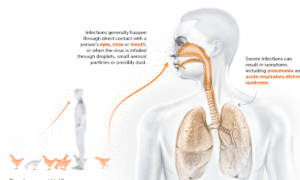

Viruses that cause influenza in animals can evolve to infect people as well. Viruses that formerly only affected animals may now be utterly harmless to humans. Because of this, people can get worse when infected with certain viruses.
A highly contagious new strain of human influenza may be produced if the H5N1 bird flu virus were to ‘combined’ with an existing strain of human influenza.
According to health experts, When the bird flu virus mutates, it might cause a global pandemic.
The virus is already infecting regions in Asia, the Middle East, Africa, and Europe. The 1918-1919 Spanish flu pandemic was the deadliest in modern history. Killing as many as 50 million people.
Current efforts to control the spread of the avian flu virus include strict quarantine regulations, testing and vaccine development, and the culling of infected poultry flocks.
Reasons For
If humans come into unprotected contact with infected birds, they can get the virus and become sick. Rarely does it spread from person to person.
The United States FAO has identified the following actions as potential human vectors for the disease:
- risk of contracting an infection
- inhaling or coming into contact with bird droppings or other infectious bird fluids
- slaughtering or butchering diseased birds,
- preparing them for food,
- selling them,
- and going to markets where they sell live birds
Humans can contract the virus through contact or senses. However, some can get infected without contact. Cooked chicken and eggs are safe to consume. Cook chicken to 165º F (74º C) and eggs until firm.
There is a possibility that bird poop has the virus and can infect water, feed, machinery, footwear, clothes, dirt, and dust. Animals can spread the H5N1 virus through their bodies, especially their feet.
Risks to Children’s “Sensory Processing” From Excessive Screen Time
Medical Evaluation
The prognosis for H5N1 avian flu can improve with an early diagnosis.
The doctor will take the following into account before making a diagnosis:
- keep an eye out for symptoms of the human flu
- Inquire about birds you may have encountered during your recent travels.
- Gather a sample of the respiratory system and have it tested by an accredited laboratory.
- It is more probable that the results will be more reliable if the patient submits this respiratory sample during the initial days of the illness.
- A/H5N1 flu tests that nasal or pharyngeal swabs can administer were authorized by the FDA in 2009.
- The test detects the virus by finding the NS1 protein.
- Unless the patient has recently been near birds or has remained in an area prone to H5N1 infection, a doctor is unlikely to diagnose H5N1 avian flu.
Medical Care


Antiviral drugs can enhance patient outcomes by decreasing the virus’s replication rate, says the (WHO). Some cases can be saved from turning fatal by using antivirals.
- Oseltamivir (Tamiflu) should be administered by doctors within 48 hours of the onset of symptoms. The high death rate, however, means that doctors may choose to provide the drug after 48 hours in the hopes of improving the patient’s prognosis.
- For individuals 13 years of age and up, the recommended dosage of Tamiflu is 75 mg. People with kidney issues or end-stage renal illness, as well as children younger than this age, will require a lower dosage.
- Although most people only need to take Tamiflu for five days, those with weak immune systems or who are sick may require a lengthier course.
- The drug’s absorption may be impaired in those who suffer from gastrointestinal issues caused by H5N1 avian flu compared to those who do not.
- According to research, some H5N1 avian flu patients may also resist this treatment.
- Isolation at home or in a hospital is the best action for anyone with confirmed or suspected avian flu.
- Medical experts recommend that, in addition to taking Tamiflu, patients should rest, stay adequately hydrated,
- consume nutritious food in moderation,
- utilize more drugs to alleviate discomfort and fever
- People infected with H5N1 avian flu often experience complications such as bacterial pneumonia. Antibiotics are necessary for everyone with bacterial pneumonia, and extra oxygen may be necessary for some.
Prevention
Stopping the spread of avian flu is an impossible task. The government, however, may assist communities in getting ready for potential diseases by observing how birds migrate.
Although avian flu cannot be vaccinated against, seasonal flu can.
The (WHO) reports that while H5N1 vaccinations have been developed, they are unsuitable for extensive use.
People can help reduce the transmission of avian flu by being cautious. Among them are:
- Cleaning one’s hands: Always use soap and warm water to wash your hands after touching food, using the restroom, or coughing.
- If you must cough, cover your mouth with a tissue or elbow and throw away the discarded tissue properly. The virus can be transmitted from person to person if you touch surfaces immediately after coughing.
- Those experiencing symptoms should isolate themselves as much as possible by avoiding social situations and others.
According to the (WHO) seasonal flu shots are ineffective against H5N1 avian flu.
Safeguards for Birds


- You shouldn’t handle raw and cooked meats with the same cutting tools. Washing hands with soap and water before and after handling raw poultry is crucial.
- Avoid birds that are sick or dead. If you need dead birds removed, contact your local government. It is essential for those who deal with domestic birds to adhere to both state and federal regulations.
When planning a trip to a region where avian flu could be prevalent, it’s essential to stay away from:
- animal waste
- markets for live animals
- hen houses
Is It Safe to Wear a Mask?
Swine flu broke out in the U.S. in 2009. In the U.S., everyone wondered how to stop the infection from spreading.
This year’s vaccination was in short supply because the virus wasn’t discovered until after vaccine production began, as the C.D.C.
People used surgical face masks to prevent disease spread.
Now that the novel coronavirus SARS-CoV-2 has recently spread, surgical face masks are being considered once again to protect against the sickness of H5N1 and other viruses.
Does it truly stop the transmission of viruses like the flu or SARS-CoV-2 when people wear face masks?
We will analyze professional advice, dissect studies to find the best masks, and show you how to wear them correctly.
Leprosy Cases In The US: The Old Sickness is Spreading, But What is it And Why is it Happening Now?
Where Do The Experts Stand?
According to the C.D.C. people can help stop the spread of new H5N1 viruses like by simply covering their faces with a mask.
It suggests that people should cover their nose and mouth when they’re out in public or wear a mask.
As with other public health measures such as frequent handwashing, avoiding close contact with infected birds and animals, and maintaining a safe distance, this can help minimize the spread of the H5N1 virus.
When dealing with flu patients, healthcare providers should all wear face masks, according to the C.D.C.
According to the C.D.C.’s recommendation, masks should be provided to patients exhibiting symptoms of respiratory infections in healthcare facilities until they can be isolated.
Wearing a mask correctly helps prevent others from getting sick if you’re unwell and must be around others.
What is The Danger of Humans, and Why Has The Avian Flu Virus Moved to Cows in The United States?


Can the bird flu pandemic already infect cattle and birds in the U.S. spread to people?
The first occurrences of bird flu in humans occurred in the United States in 2022 when the virus travelled from chicken farms in 14 states to cows and then to two individuals. What scientists call a “global pandemic for animals” involves the spread of the same subtype of bird flu in different countries.
Since the initial cow epidemic was identified in March, public health officials in the U.S. have been closely watching dairy cow herds and beef and milk products nationwide. There is concern that avian flu, which has only been identified in livestock in the United States, could also seriously infect humans.
A farmhand in Texas became infected in April, marking what is likely the first known instance of the virus being passed from a mammal (cows in this instance) to a human. Fortunately, he had a slight conjunctivitis and an eye infection and has now totally recovered.
After coming into contact with contaminated chicken in 2022, a poultry farm worker in Colorado became the first person in the United States to suffer from bird flu.
Fatigue was the sole symptom he mentioned.
On the other hand, humans are highly vulnerable to avian flu. The reports that 860 humans in 23 countries, including China, Egypt, Vietnam, and Turkey, have contracted the virus via birds since its initial detection nearly 30 years ago in China.
There was a shockingly high mortality rate of 52% among those 463 persons who contracted the illness.
The virus has been found in over 90 million hens, 9,000 wild birds, and 200 cows in the U.S.
Canada followed Colombia’s lead last week and instituted tighter import checks for U.S. livestock on Friday.
What Percentage of Cattle in the United States Have Avian Flu?
From late March to the present, 36 dairy cattle farms in the U.S. states of Colorado, South Dakota, Kansas, Michigan, North Carolina, Idaho, Texas, Ohio, and New Mexico have reported approximately 200 animals infected with H5N1.
According to some scientists, the disease might have started infecting cows before March—possibly as early as late 2023—but no one noticed.
“The extent to which this might be prevalent is something we are unaware of,” Davis stated. “We require extensive monitoring, numerous observers, and diverse perspectives to tackle this challenge.”
Is It Possible For Avian Flu to Infect Livestock In Other Nations?


There may be a risk of bird flu spreading internationally through migrating birds, according to the (WHO), even though no verified cases of the disease in cows outside the U.S. boundaries have been reported thus far.
“There is a risk for cows in other countries to be getting infected with the virus that migratory birds carry around the world,” stated Wenqing Zhang, head of the WHO’s Global Influenza Programme, during a news briefing in Geneva in late April.
What Is The Risk of Human Infection With Avian Flu?
According to the H5N1 is “highly pathogenic,” which means it can “strongly cause disease” in birds. However, there have been instances where it has been fatal to people. More than half of the 860 people who have been infected with the virus since its discovery in 1996 have died from it, according to the (WHO).
- Those in greatest danger are farm labourers and everyone else who comes into close touch with diseased animals.
- There was one possible case of human-to-human transmission in Indonesia in 2006. Still, beyond that, it is doubtful that people can spread the virus to one another.
- Within two to eight days following infection, people can experience various symptoms caused by avian flu. Symptoms might vary from mild ones like a runny nose and cough to more serious ones like pneumonia and organ failure.
Is There a Way to Cure Human Cases of Avian Flu?
People cannot be protected against avian flu by vaccination. Individuals infected with the virus are usually given antiviral medication like zanamivir or oseltamivir to alleviate symptoms. According to health authorities such as the C.D.C., such medications should be administered promptly upon the onset of symptoms.
When A Virus Comes Out, How Do Farmers Handle The Situation?
When a fatal virus, like avian flu, breaks out, farmers around the world slaughter all animals that have been exposed. For example, in early April, a Texas poultry farm slaughtered 1.5 million birds to control the spread of bird flu.
No reports of cow culling have been made thus far. According to an assistant professor, Andrew Stevens, the impact of avian flu on cows has not been as severe as it has been on chickens and turkeys.
Culling would be expensive and drastic to stop the disease from spreading in this environment. The reason behind this is that the level of contagiousness between cattle and the avian flu virus is still not well understood, he added.
How Does The Bird Flu Virus Go From Birds To Humans And Other Animals?


Spitting or other secretions from wild birds or waterfowl, such as ducks or geese, can spread the bird flu virus.
When they scavenge, poultry and other animals can contract the virus from diseased birds or contaminated habitats. Although researchers are still examining these potential avenues of transmission, Davis did mention that infected wild birds could be present on farms and come into touch with water or grain that cows consume.
Traces of the virus in milk indicate a substantial viral load can often be discovered in the mammary glands. However, the exact mechanism of the virus’s transmission from cow to cow remains unknown in cattle. The higher viral load in milk can explain the pathways of exposure to the virus compared to the respiratory tracts.
Because of the potential for infected equipment or the virus to get aerosolized or suspended in the air while cleaning, scientists believe that the virus spreads during milking cows.
When humans come into close or extended contact with wild birds or farm animals, they risk contracting the virus through their eyes, mouths, or noses due to inhaled droplets or minute aerosol particles.
Are Milk and Beef Potential Vectors For The Spread of Avian Flu?
Including milk, cottage cheese, and sour cream, (F.D.A.) has examined 297 items since April.
Additional research has proven that pasteurization, a heating technique farmers use to screen out hazardous viruses and germs from farm products, destroys the virus, removing the danger for consumers. Initially, traces of the virus were identified in 20% of the 96 samples.
To prevent bacterial diseases like salmonella and brucella, as well as bird flu, experts and public health agencies, such as the C.D.C., urge the public to eat pasteurized dairy products exclusively.
Although the U.S. Department of Agriculture (U.S.D.A.) has confirmed that its beef samples do not contain any signs of avian flu, the F.D.A. continues to warn against eating raw beef.
Concerns Over the Safety of Eating Runny Eggs Caused by Recent Bird Flu Outbreak


With the confirmation of a second human case of bird flu this week, along with outbreaks at two of the biggest commercial egg producers and multiple dairy farms, public health worries in the United States regarding bird flu have intensified.
The spread of avian influenza has coincided with warnings regarding the consumption of certain runny dairy products and eggs.
A fact sheet regarding avian flu and safe cooking procedures from the New Hampshire Department of Health and Human Services is currently making the rounds on social media, with the message to “make sure eggs are fully cooked so that the yolks are not runny or liquid.”
Firm yolks are recommended by the U.S.(F.D.A.) for cooking eggs. Make sure to use pasteurized eggs in recipes that call for raw or undercooked eggs at serving time. Pasteurization can inactivate viruses and germs.
However, according to the U.S.D.A., humans cannot contract the avian flu by consuming fowl or eggs.
A zoonotic disease expert at the University of Massachusetts in Amherst, Stephen Rich, PhD, says, “The risk of getting avian flu from eggs is relatively low, and from cooked eggs, it’s probably shallow.” diseases that start in animal populations but can sometimes spread to humans.
According to him, undercooked eggs provide a substantially higher risk of gastrointestinal disease due to salmonella germs.
Research has demonstrated that any virus contaminating poultry meat may be inactivated by appropriate cooking, easing concerns about chicken meat as a potential transmission point.
Be Calm and Cook Your Eggs Properly
Rich claims people shouldn’t freak out about the avian flu pandemic. He assures the public that the virus is extremely rare in humans and that afflicted individuals do not spread the disease.
Rich advises that people should not be too worried because the risk of contamination to humans is still low; however, if they would like to be extra careful, they can be more careful while ordering or preparing eggs.
Not All Dairy Products Undergo Pasteurization, Right?
A rising number of people in Western nations like the United States regard the fight against food control as a sign of independence. For instance, the Food Freedom Act, which Wyoming enacted in 2015, permits farmers to sell farm goods directly to consumers, including raw milk.
A “Raw Milk Movement” is gaining traction in Australia, the only nation with a complete prohibition on selling raw milk (the other being Canada), in favor of controlled distribution of unpasteurized goods. Hygienic production and packing of milk, together with testing for active dangerous microorganisms, would be part of these standards.
Although 30 states in the U.S. permit the selling of raw milk, it is illegal to transport unpasteurized milk from one state to another according to federal law.
On top of that, federal legislation mandates the total disposal of milk from ill cows. However, if raw milk is processed before sick animals are discovered, goods containing the virus could still reach store shelves.
Research ethics have prevented any such study on people. Still, investigations in the United States on cats found that drinking raw milk infected with H5N1 made the cats sick or even killed them.
Given The Recent Avian Flu Outbreak, How Are U.S. Authorities Handling the Situation?
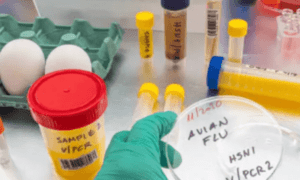

As a result of the COVID-19 pandemic, there have been good changes in terms of preparation for outbreaks, according to experts and public health authorities like the C.D.C., which have been studying bird flu for decades.
Regulatory bodies are also ramping up virus surveillance. According to the U.S.D.A., testing for bird flu became mandatory for all dairy cattle crossing state lines in late April.
Davis cautioned that more than volunteer testing at farms within states may be required to control the virus’s spread.
She expressed her desire to shift from “more passive surveillance,” in which the government merely waits for farmers and workers to report problems, to “more active surveillance,” in which the government actively seeks to grasp the extent of the problem.
She mentioned antibody serology testing as one method for doing this. This test involves taking a person’s blood or saliva sample and then analyzing it to see if their immune system has recently been exposed to the virus.
Polymerase chain reaction (PCR) testing is another option; however, it is more invasive and may not be appropriate for asymptomatic or without significant viral exposure, according to Davis, since it involves nose swabs to detect infection.
She said that people living in rural areas of the United States may be even more vulnerable to the epidemic since they may not have easy access to medical treatment or P.P.E. Hospitals and clinics may be too far away.
The cost of care may be too high for some communities. Would the workforce have the chance to get tested if farmers aren’t interested in testing cows? She indicated that it was not clear.
The U.S. Faces a Bird Flu Problem; How Are Other Countries Responding?
Colombia was the first nation to restrict commerce with the United States in response to bird flu in cattle at the end of April. States with cows that have tested positive for the virus have had their beef and beef products barred from being imported.
According to the agriculture ministry, Mexico has stepped up its monitoring of incoming cattle for symptoms of respiratory distress because the nation is a significant market for American beef and dairy products.
Canadian Food Inspection Agency officials tightened restrictions on U.S. cattle imports last Friday. Exporters of lactating dairy cattle now need to produce negative findings from bird flu tests, and retail milk must be tested for evidence of the virus.
According to Stevens, these actions are critical to the future viability of supply chains. “The potential impacts of an import ban or moratorium outweigh the small expenses of increasing import checks of U.S. cattle and dairy products, even though these costs may slightly increase the relative costs of U.S. exports.”
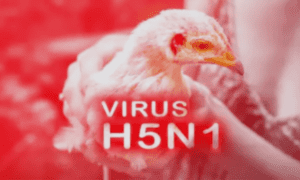

FAQs
The bird flu is what?
Influenza A and B viruses affect wild birds worldwide and cause bird flu. Less frequently, they can infect other types of animals, although they can also spread to commercial or backyard fowl.
Could you tell me the signs of avian flu?
Infected birds might have various symptoms, including runny nose, coughing, sneezing, diarrhea, lethargy, reduced egg production, and, in rare cases, abrupt death.
Humans infected with avian flu may have flu-like symptoms in humans, including high body temperature, coughing, sore throat, nasal discharge, and muscular aches and pains. Humans may have vomiting, diarrhea, and, very infrequently, convulsions.
In most cases, how does avian flu spread?
The majority of illnesses happen when people come into touch with diseased animals, either alive or dead, and do not use protective gear.
In what ways might birds infect cows?
The contagious virus carrying bird flu is shed in infected birds’ saliva, mucus, and excrement, which can affect various bird species. Cows are among the animals that could get infected by the virus that is shed.
Does one person can infect another with avian flu?
Viruses that infect birds rarely infect humans. The transmission from animals to humans is more frequent. No indication of long-term transmission from humans has been found.
Could bird flu have changed in a way that makes it easier to transfer to people?
The virus may mutate to become more easily transmissible among humans, but it’s not sure. There is no evidence that avian flu is more easily transferred between humans. Unprotected close contact with sick or deceased animals is the leading cause of human cases of bird flu.
Is it safe for humans to eat dairy products and beef?
Killing diseased animals and not selling their products is the right thing to do. Infectious viruses in milk can be killed by pasteurization. Consuming raw milk from an infected cow could spread the disease.
What are the ways that people can treat avian flu?
Human influenza treatment for bird flu is very similar. One viable alternative for treating bird flu in humans is the antiviral oseltamivir, most commonly known as Tamiflu.
To avoid contracting bird flu, what precautions may people take?
It is essential to take precautions when handling ill or deceased animals. Among these are several kinds of birds and fowl. When handling animals or any substance that could be contaminated with the virus, individuals who work with them should wear full protective gear. Among these items are an N95 mask or a similar one, goggles, gloves, a robe, a cap, and a pair of boot covers.
Is it possible for my dog and cat to contract avian flu?
They could choke on a dead bird if they’re playing around the neighborhood. We have also seen cases of cats contracting the disease after consuming milk from the afflicted cows. Even zoo big cats can get it; domestic cats and dogs aren’t immune. So far, we haven’t observed any cases of diseased dogs or cats infecting their owners.
What level of concern is warranted regarding avian flu now? Will this epidemic be the next one?
Trying to put this in perspective is incredibly challenging. At the present time, this virus is tricky for humans to contract.
However, this particular influenza virus is one that I would like not to contract. It has yet to become ubiquitous in humans despite our 25 years of tracking it. However, it has recently been found in animals in South America, and the only time we’ve ever seen it in the U.S. was temporary.
While the direct threat to people may be minimal at the moment, the relative danger is more significant than it has ever been. The fact that influenza viruses may adapt to human bodies is well-established. H1, H2, and H3 avian influenza strains have also crossed over.
The potential for this to become a pandemic is very concerning, given the historical evidence that influenza viruses can do this. Only three of the sixteen flu strains found in birds have infected people. For some, this means the other thirteen kinds can’t transition to humans. They can pull this off even if it’s less risky and more complex. It’s simply not zero.
Greetings! Your voice is valuable to me. Please feel free to share your thoughts, feedback, recommendations, or requests for future content. Your contributions are welcomed and appreciated. Rest assured that your input will remain confidential and free of charge. Please subscribe, like, and share. Thanks, and have a nice day


